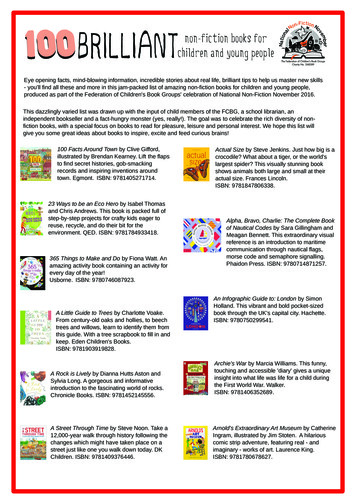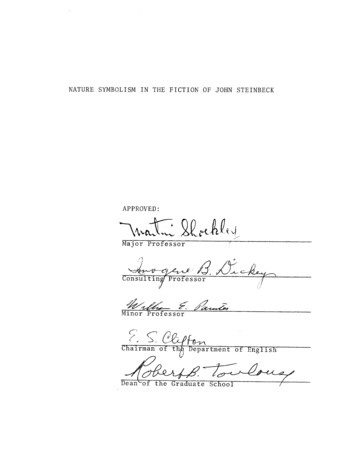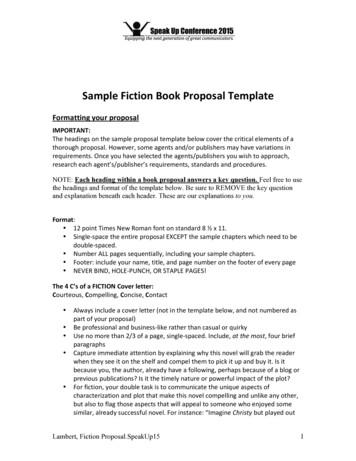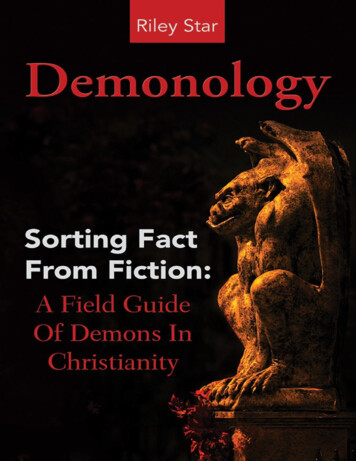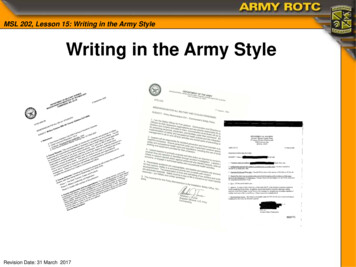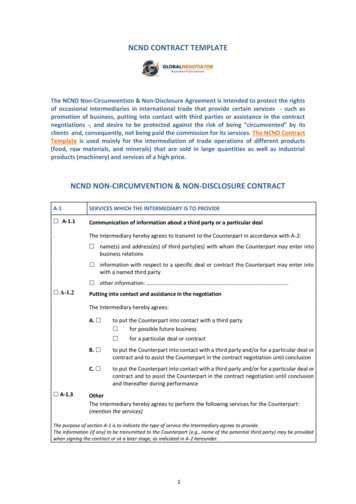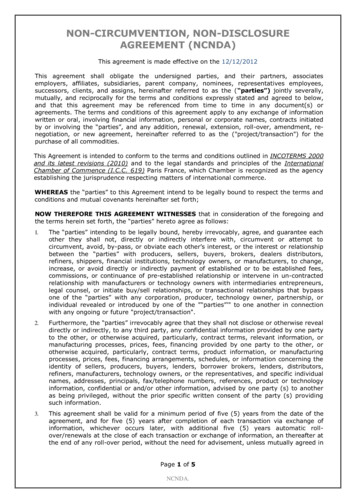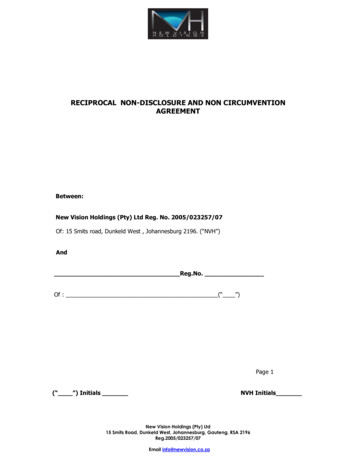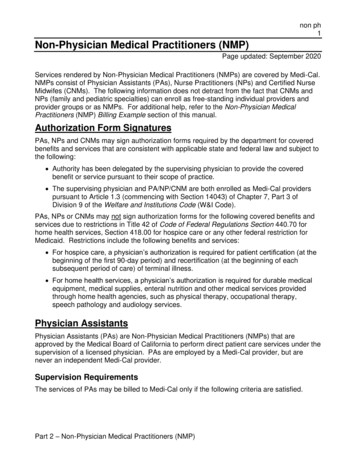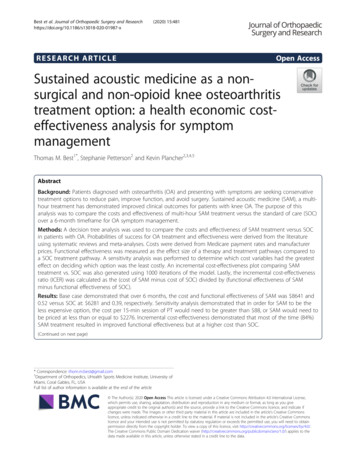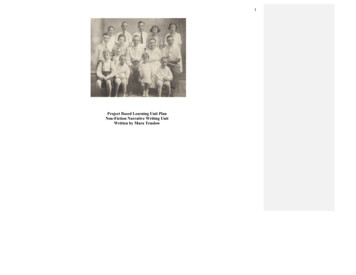
Transcription
1Project Based Learning Unit PlanNon-Fiction Narrative Writing UnitWritten by Mara Truslow
2Table of Contents:Overview of Project .3Project and Learning Guide .5Project Calendar .6Assessment Map .10Technology Emphasis Explained 11Assessment 1 12Assessment 2 13Lesson Plan 1 .20Lesson Plan 2 32Additional Note on Lesson Plans .42
3
4
5P R O J E C TD E S I G N :S T U D E N TL E A R N I N GG U I D EProject: Non-Fiction Narrative WritingDriving Question: What shaped our family members’ lives and how can we capture these moments using research techniques and creative writing to tell their stories?Final Product(s)Presentations,Performances,Products and/orServicesLearning Outcomes/Targetscontent & 21st century competenciesneeded by students to successfullycomplete productsInterview Transcript Students will need to brainstorm different storiesHistorical Introduction from family members and initiate an interviewprocess, which requires strong communicationskills. Students will also need to collaborate withother team members to research the historicalNarrative Non-Fiction period.Journal of FamilyHistoryCheckpoints/Formative Assessmentsto check for learning and ensurestudents are on trackInstructional Strategies for All Learnersprovided by teacher, other staff, experts; includesscaffolds, materials, lessons aligned to learningoutcomes and formative assessmentsStudents will complete their “Need to Know”lists for each aspect of the interview process,which will be graded. Students will need tosubmit the transcript of their interview. Studentswill work in groups and will be responsible forsubmitting their historical guides.For students who struggle to identify a familymember or event, lists of possible topics will begiven to students. The same will be true ofinterview questions. Students who struggle totranscribe interviews will be given assistivetechnology.Students will use creativity and innovationcompetencies to compose a narrative based onthe interview they conducted. Students will alsoneed to use critical thinking skills to successfullytranslate an interview into a piece of creativewriting.Students will be submitting portions of theiressay on a daily basis after working in class.Students will also be held accountable to peerediting.For students who are struggling writers,additional scaffolds like sentence starters andoutline guides will be provided. The teacher willalso pull struggling students in small groupsduring the drafting process to guide writing.Students will need to collaborate extensively todetermine tasks and compile a book of all nonfiction works. Students will also need to use theircommunication skills to successfully put togethera coherent and cohesive book of their work.The teacher will designate team leaders for eachelement of the project who will be responsible forreporting what has been completed and what isleft to be finished. Students will also completeexit tickets on their contributions and reflectionson the publication of the project.For students who are less vocal, they will begiven more specific responsibilities to ensurethey are involved in the publication process.Students will be grouped heterogeneously topromote collaboration and mentorship.
6P R O J E C TC A L E N D A RProject: Non-Fiction Narrative WritingM O N D A Ypage 1Time Frame:TUESDAYWEDNESDAYP R O J E C TW E E KTHURSDAYF R I D A YO N EOverview: The first week of the unit focuses on introducing the idea of narrative non-fiction and the purpose of the assignment. Students will brainstorm family membersthey want to interview. They will select one story and will develop interview questions to administer over the weekend.Students will read examples ofinterview questions and narrative nonfiction.Standard .RI.7.10Students will discuss types ofquestions they are asked about theirfutures.Teacher will introduce the projectand the driving question of theproject.Students will begin filling in graphicorganizers to brainstorm potentialstories from family members.Standard Alignment:CCSS.ELA-LITERACY.W.7.3Teacher begins addressing historical Students share selected sources andand journalistic research.primary sources in groups.Teacher models how to brainstorm a Groups work together to helpstory and generate questions.teammates select one story they willStudents create need to knowwrite about for their non-fictionquestions based on the story ideas they narrative.generated.As homework, students should bringTeacher introduces HW assignment to more primary sources relating to thefind more information about storiesstory.and bring back primary sources.Standard Alignment:Standard .W.7.8P R O J E C TW E E KTeacher models how to developinterview questions based on a familystory you are familiar with.Students will begin developinginterview questions based on theirstory and will interview (and record)their family member over theweekend.Standard Alignment:CCSS.ELA-LITERACY.W.7.8T W OOverview: This week, students will research the time period of their story, will transcribe and introduce their narrative, and will transition back to analyzing the craft movesmost frequently used in narrative non-fiction.Students should be grouped based on Students work in peer groups afterthe time period and setting of theirtranscribing the interviews to generatestory.key points/ takeaways from theinterviews.Teacher models how to collectpreliminary research on a topic.Standard Alignment:Students begin their preliminaryCCSS.ELA-LITERACY.W.7.6research of the time period in groups.Standard Alignment:CCSS.ELA-LITERACY.W.7.8Teacher reintroduces narrative non- Students analyze the key craft movesfiction, emphasizing the importance of used in narrative non-fiction.basing it on a historical event.Standard Alignment:Students write an introduction,CCSS.ELA-LITERACY.W.7.3.Bintegrating historical context, to theirtranscript of the interview.Standard Alignment:CCSS.ELA-LITERACY.W.7.3Students analyze the key craft movesused in narrative non-fiction (cont’d).Standard Alignment:CCSS.ELA-LITERACY.W.7.3.B
7Project: Non-Fiction Narrative WritingM O N D A Ypage 3TUESDAYWEDNESDAYP R O J E C TW E E KTHURSDAYF R I D A YT H R E EOverview: Students will draft their non-fiction narratives after analyzing how craft moves contribute to the development of a non-fiction narrative.Students answer “Need to Know”questions for the planning stage oftheir narrative.Students critique a piece of narrativenon-fiction focusing on the craftmoves they do/do not use.Standard Alignment:CCSS.ELA-LITERACY.W.7.5Standard Alignment:CCSS.ELA-LITERACY.W.7.5Students begin drafting their work of Students continue drafting their work Students continue drafting their worknarrative non-fiction.of narrative non-fiction.of narrative non-fiction.Standard CY.W.7.3.CStandard CY.W.7.3.CIf students are not finished, they willtake complete the drafting processover the weekend.Teacher should give feedback ondrafts over the weekend.Standard CY.W.7.3.CP R O J E C TW E E KF O U ROverview: After completing the drafting process, students will peer-revise their narratives. Afterwards, students will work collaboratively to compile and publish their Journalof Family History and plan the event where they will share their writing.Students will peer-revise theirnarrative non-fiction.Standard Alignment:CCSS.ELA-LITERACY.W.7.5Students will continue/finish peerrevising their narrative non-fiction.Teacher should assign student jobs to Students organize the Journal ofStudents take summative assessmentput together the Journal of FamilyFamily History event for the schoolwhere they write an analyticalHistory.that will take place on Friday evening. summary analyzing the craft movesIf a student did not finish editing theirThey need to organize all event details. used in a narrative.narrative, they should take it home to Students will have two days to workfinish over the weekend.collaboratively to compile and publish Standard Alignment:Standard Alignment:the Journal of Family .7.3.BStandard Alignment:CCSS.ELA-LITERACY.W.7.5Standard Alignment:CCSS.ELA-LITERACY.W.7.6
8Standards for Reference:CCSS.ELA-LITERACY.W.7.3Write narratives to develop real or imagined experiences or events using effective technique, relevant descriptive details, and well-structured eventsequences.CCSS.ELA-LITERACY.W.7.3.AEngage and orient the reader by establishing a context and point of view and introducing a narrator and/or characters; organize an event sequence thatunfolds naturally and logically.CCSS.ELA-LITERACY.W.7.3.BUse narrative techniques, such as dialogue, pacing, and description, to develop experiences, events, and/or characters.CCSS.ELA-LITERACY.W.7.3.CUse a variety of transition words, phrases, and clauses to convey sequence and signal shifts from one time frame or setting to another.CCSS.ELA-LITERACY.W.7.3.DUse precise words and phrases, relevant descriptive details, and sensory language to capture the action and convey experiences and events.CCSS.ELA-LITERACY.W.7.3.EProvide a conclusion that follows from and reflects on the narrated experiences or events.CCSS.ELA-LITERACY.W.7.5With some guidance and support from peers and adults, develop and strengthen writing as needed by planning, revising, editing, rewriting, or trying anew approach, focusing on how well purpose and audience have been addressed. (Editing for conventions should demonstrate command of Languagestandards 1-3 up to and including grade 7 here.)CCSS.ELA-LITERACY.W.7.6Use technology, including the Internet, to produce and publish writing and link to and cite sources as well as to interact and collaborate with others,including linking to and citing sources.CCSS.ELA-LITERACY.W.7.7Conduct short research projects to answer a question, drawing on several sources and generating additional related, focused questions for furtherresearch and investigation.CCSS.ELA-LITERACY.W.7.6Use technology, including the Internet, to produce and publish writing and link to and cite sources as well as to interact and collaborate with others,including linking to and citing sources.
9CCSS.ELA-LITERACY.W.7.8Gather relevant information from multiple print and digital sources, using search terms effectively; assess the credibility and accuracy of each source;and quote or paraphrase the data and conclusions of others while avoiding plagiarism and following a standard format for citation.CCSS.ELA-LITERACY.RI.7.10By the end of the year, read and comprehend literary nonfiction in the grades 6-8 text complexity band proficiently, with scaffolding as needed at thehigh end of the range.
10Outline of the narrativeInformational/CreativeWritingPeer and teacher critique ofrough draftDrafting the non-fictionnarrativeNarrative Non-Fiction StoryLiterary Devices ResearchConduct and interpret aninterview with a familymemberExit tickets after lessonsAnalytical summary of peernarrativeUse rhetorical moves todevelop a narrativeCreativity and InnovationUse creative embellishmentsin storytellingDetermine an effective storyby asking and answering Qs
11Technology Emphasis ExplainedThe first place where technology is utilized is during the historical research on the time period of the narrative. Students will work in groups usingiPads and laptops. Students will rely heavily on Google Cultural Institute, and primary/ secondary databases to collect contextual information abouttheir topics. This work will require students to use their research competencies and work together to discern what information is most important andrelevant to their topic.The second technology piece is compiling and publishing the Journal of Family History. Students will need to use on-line publishing software tolayout all student narratives. The students will also have the opportunity to include transcripts and primary source material in the book. Students willneed to work collaboratively to determine the layout of the book. This task will also require a great deal of creative energy. Creating a book is animportant 21st century task that all students should have the opportunity to experience at a young age.
12Assessments:Assessment 1:The non-fiction narrative is one of two summative assessments. Students will be introduced to the TNCore rubric at the beginning of the year, whichwill be used to track all writing assessments. During the peer editing process and the draft review, the teacher should use this rubric as a basis forproviding students with feedback. This rubric will be used to grade all non-fiction narratives.
13Assessment 2:Since the non-fiction narrative focuses on the development of craft moves and how craft moves contribute to the central idea, students will analyze anon-fiction text to assess how craft moves contribute to the central idea. The text, This American Life: Loopholes, is a piece of literary non-fiction.The assessment is an on-demand writing task, which aligns with the Common Core mandate that students need to diversify the ways and types ofwriting they engage with. Students will have one hour to complete this exam and it will be graded using the same TNCore Rubric. This test can beadministered on paper or on a computer.
14Writing Task IntroductionIra Glass is a well-know radio journalist who narrates and produces a weekly radio broadcast on NPR called This American Life. During this assessment, youwill read a transcript of the Prologue to the radio show.1. Analytic SummaryPlease read “This American Life: Loopholes” by Ira Glass, a non-fiction narrative. In this text, the author develops a central idea. After you have read,determine the centr
CCSS.ELA-LITERACY.W.7.3.B Use narrative techniques, such as dialogue, pacing, and description, to develop experiences, events, and/or characters. CCSS.ELA-LITERACY.W.7.3.C Use a variety of transition words, phrases, and clauses to convey sequence and signal shifts from one time frame or setting to another. CCSS.ELA-LITERACY.W.7.3.D Use precise words and phrases, relevant
